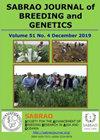越南不同山茶种rbcL和trnH-psbA DNA条形码的比较
IF 1.7
Q3 PLANT SCIENCES
引用次数: 1
摘要
山茶属山茶科中的一个大属。在该属中,有几个物种具有不同的用途,例如药用和观赏植物以及饮料生产。因此,在全国范围内种植各种山茶属植物,以减轻贫困,促进许多地区的经济发展。然而,评估其遗传资源作为保护和开发这种植物的基础的研究尚未开始。目前,使用DNA条形码通常是识别和表征大量植物的一种高度可靠的方法。在本研究中,越南胡志明市食品工业大学于2020-2022年对从越南淡岛区淡泉公社东布阿村和永福省采集的10份山茶属材料进行了研究。对rbcL和trnH-psbA这两个DNA条形码区域的评估表明,它们能够区分越南不同物种的山茶属材料。结果表明,山茶属植物rbcL和trnH-psbA区域的DNA序列存在显著差异。此外,trnH-psbA条形码区域在识别各种山茶属植物方面也显示出比rbcL区域更高的有效性。结果验证了DNA条形码在越南山茶遗传资源管理、保护和开发中的潜力。本文章由计算机程序翻译,如有差异,请以英文原文为准。
COMPARISON OF rbcL AND trnH-psbA DNA BARCODES IN DIVERSE CAMELLIA SPECIES COLLECTION IN VIETNAM
Camellia is a large genus in the tea family of Theaceae. In this genus, several species serve different purposes, such as, medicinal and ornamental plants and beverage production. Thus, country-wide cultivation of various species of Camellia genus sought to alleviate poverty and promote economic development in many regions. However, studies on evaluating its genetic resources as a foundation for the conservation and development of this plant are yet to start. Currently, using DNA barcoding often serves as a highly reliable approach to identifying and characterizing numerous plants. In the presented study, a total of 10 Camellia accessions collected from Dong Bua village, Tam Quan commune, District Tam Dao, and Vinh Phuc province, Vietnam, underwent study during 2020–2022 at Ho Chi Minh City University of Food Industry, Vietnam. Evaluation of two DNA barcoding regions, namely, rbcL and trnH-psbA, transpired for their ability to distinguish the Camellia accessions belonging to different species in Vietnam. The results revealed a significant difference in the DNA sequences of the rbcL and trnH-psbA regions among the Camellia species. In addition, the trnH-psbA barcode region also showed higher effectiveness versus the rbcL region in recognizing various species of Camellia. The results authenticated the potential of DNA barcoding in the management, conservation, and development of the genetic resources of Camellia in Vietnam.
求助全文
通过发布文献求助,成功后即可免费获取论文全文。
去求助
来源期刊

Sabrao Journal of Breeding and Genetics
农林科学-奶制品与动物科学
CiteScore
1.90
自引率
50.00%
发文量
63
期刊介绍:
The SABRAO Journal of Breeding and Genetics is an international journal of plant breeding and genetics research and was first published in 1969. It is the official publication of the Society for the Advancement of Breeding Research in Asia and Oceania (SABRAO).
Its objectives are to: promote the international exchange of research information on plant breeding and genetics, by describing new research findings, or ideas of a basic or practical nature; and be a medium for the exchange of ideas and news regarding members of the Society.
The Journal gives priority to articles that are of direct relevance to plant breeders and with emphasis on the Asian region. Invited for publication are research articles, short communications, methods, reviews, commentaries, and opinion articles. Scientific contributions are refereed and edited to international standards.
The journal publishes articles for SABRAO members mainly. The Journal preferred strongly that at least one author should be a current member of the Society. Non-members may also publish in the journal.
 求助内容:
求助内容: 应助结果提醒方式:
应助结果提醒方式:


